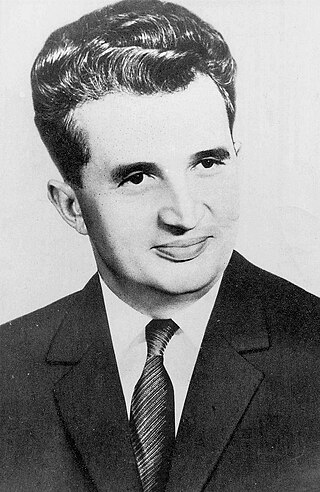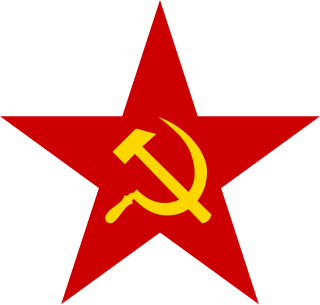Related Research Articles

Nicolae Ceaușescu was a Romanian politician who was the second and last communist leader of Romania, serving as the general secretary of the Romanian Communist Party from 1965 to 1989. Widely classified as a dictator, he was the country's head of state from 1967 to 1989, serving as President of the State Council from 1967 and as the first President of the Republic from 1974. He was overthrown and executed in the Romanian Revolution in December 1989 along with his wife Elena Ceaușescu, as part of a series of anti-communist uprisings in Eastern Europe that year.

The Socialist Republic of Romania was a Marxist–Leninist one-party socialist state that existed officially in Romania from 1947 to 1989. From 1947 to 1965, the state was known as the Romanian People's Republic. The country was an Eastern Bloc state and a member of the Warsaw Pact with a dominant role for the Romanian Communist Party enshrined in its constitutions. Geographically, RSR was bordered by the Black Sea to the east, the Soviet Union to the north and east, Hungary and Yugoslavia to the west, and Bulgaria to the south.

The Romanian revolution was a period of violent civil unrest in Romania during December 1989 as a part of the revolutions of 1989 that occurred in several countries around the world, primarily within the Eastern Bloc. The Romanian revolution started in the city of Timișoara and soon spread throughout the country, ultimately culminating in the drumhead trial and execution of longtime Romanian Communist Party (PCR) General Secretary Nicolae Ceaușescu and his wife Elena, and the end of 42 years of Communist rule in Romania. It was also the last removal of a Marxist–Leninist government in a Warsaw Pact country during the events of 1989, and the only one that violently overthrew a country's leadership and executed its leader; according to estimates, over one thousand people died and thousands more were injured.

The Grivița strike of 1933 was a railway strike which was started at the Grivița Workshops, Bucharest, the Kingdom of Romania in February 1933 by workers of Căile Ferate Române. The strike was brought about by the increasingly poor working conditions of railway employees in the context of the worldwide Great Depression, which affected Romania significantly. As the workers occupied the workshops, the Romanian Army surrounded and sieged them. The fighting resulted in the death of 7 workers, including Vasile Roaită, a 19-year-old worker whose image was used by the early Communist regime.
The June 1990 Mineriad was the suppression of anti-National Salvation Front (FSN) rioting in Bucharest, Romania by the physical intervention of groups of industrial workers as well as coal miners from the Jiu Valley, brought to Bucharest by the government to counter the rising violence of the protesters. This event occurred several weeks after the FSN achieved a landslide victory in the May 1990 general election, the first elections after the fall of the communist regime of Nicolae Ceaușescu. Many of the miners, factory workers, and other anti-protester groups, fought with the protesters and bystanders. The violence resulted in some deaths and many injuries on both sides of the confrontations. Official figures listed seven fatalities and hundreds of injured, although media estimates of the number killed and injured varied widely and were often much higher.

Octav Băncilă was a Romanian realist painter and left-wing activist. He was the brother of Sofia Nădejde, a feminist journalist, and the brother-in-law of Ioan Nădejde.
The Socialist Party of Romania was a Romanian socialist political party, created on December 11, 1918 by members of the Social Democratic Party of Romania (PSDR), after the latter emerged from clandestinity. Through its PSDR legacy, the PS maintained a close connection with the local labor movement and was symbolically linked to the first local socialist group, the Romanian Social-Democratic Workers' Party. Its creation coincided with the establishment of Greater Romania in the wake of World War I; after May 1919, it began a process of fusion with the social democratic groups of in the former territories of Austria-Hungary — the Social Democratic Parties of Transylvania, Banat and Bukovina. The parties adopted a common platform in October 1920. Progressively influenced by Leninism, the PS became divided between a maximalist majority supporting Bolshevik guidelines and a reformist-minded minority: the former affiliated with the Comintern as the Socialist-Communist Party in May 1921, while the minority eventually established a new Romanian Social Democratic Party.

Ion Costache Frimu was a Romanian socialist militant and politician, a leading member of the Social Democratic Party of Romania (PSDR) and labor activist. He died after being beaten and contracting an illness in prison, where he was being held for his participation in the typographic workers' demonstration of December 1918.
Romanian architecture is very diverse, including medieval, pre-World War I, interwar, postwar, and contemporary 21st century architecture. In Romania, there are also regional differences with regard to architectural styles. Architecture, as the rest of the arts, was highly influenced by the socio-economic context and by the historical situation. For example, during the reign of King Carol I (1866–1914), Romania was in a continuous state of reorganization and modernization. In consequence, most of the architecture was designed by architects trained in Western European academies, particularly the École des Beaux-Arts, and a big part of the downtowns of the Romanian Old Kingdom were built during this period.

Carlton Bloc was a residential block located in Bucharest, Romania, at 9 Nicolae Bălcescu Boulevard, completed in October 1936. Having 14 floors and a height of 47 metres (154 ft), it was the tallest building in the capital until it completely collapsed in 1940 in an earthquake.

Ion I. Câmpineanu was a Romanian statesman who served as the Minister of Justice from January 27, 1877, to September 23, 1877, Minister of Finance in two terms, from September 23, 1877, to November 25, 1878, and from February 25, 1880, to July 15, 1880, and Minister of Foreign Affairs from November 25, 1878, until July 10, 1879. He was one of the founders and most important members of the National Liberal Party.
Leonte Filipescu was one of the leaders of the early Romanian communist movement, shot in custody by the Romanian authorities.

Alexandru "Alecu" Constantinescu was a Romanian trade unionist, journalist and socialist and pacifist militant, one of the major advocates of the transformation of the Romanian socialist movement into a communist one.

Gheorghe Gh. Mârzescu was a Romanian lawyer, journalist and politician. A member of the National Liberal Party (PNL), he was Minister of Agriculture (1916–1918), Interior (1918–1919), Labor and Social Protection (1922–1923) and Justice (1923–1926) in successive cabinets of Ion I. C. Brătianu.

Dissent in Romania under Nicolae Ceaușescu describes the voicing of disagreements with the government policies of Communist Romania during the totalitarian rule of Nicolae Ceaușescu after the July Theses in 1971. Because of Ceaușescu's extensive secret police and harsh punishments, open dissent was rare. Notable acts of dissent include Paul Goma's 1977 letters to Ceaușescu, the founding of SLOMR in 1979 and a number of work conflicts, such as the Jiu Valley miners' strike of 1977 and the Braşov Rebellion of 1987.

Alexandru Ionescu was a Romanian typographer, early labour leader and socialist journalist. A founding member of Romanian Social Democratic Workers' Party (PSDMR), he was part of its leadership throughout its existence, at the same time working for the unionisation of the Romanian workers. One of the few party leaders with actual working-class background, Ionescu opposed collaboration with the bourgeois political parties, and continued to support the existence of a workers' party even after the other leaders of PDSMR decided on the party's dissolution. A founder, along fellow-minded socialists, of the Working-class Romania circle, Ionescu grew estranged from the main socialist grouping due to disagreements over the newly established labour legislation. Joining the government-sanctioned corporations, he supported at times ideas contradictory to his former socialist positions, but ultimately he rejected corporatism as a form of labour organisation. Despite some attempts at collaboration, he would never reintegrate in the mainstream socialist movement.

Ottoi Călin was a Romanian physician, journalist and socialist militant, considered one of the theoreticians of the Romanian workers' movement during the early 20th century.

Ilie B. Moscovici was a Romanian socialist militant and journalist, one of the noted leaders of the Romanian Social Democratic Party (PSDR). A socialist since early youth and a party member since its creation in 1910, he returned from captivity in World War I to lead the PSDR from Bucharest, and involved himself in a violent clash with the Romanian authorities. He mediated between reformist and Bolshevik currents, and helped establish the Socialist Party of Romania (PS) as a fusion of both tendencies. Moscovici served as a PS representative in Chamber, but was deposed over his instigation of the 1920 general strike, then imprisoned. Although he voted against the creation of a Communist Party from the rump PS and criticized Comintern interference in Romanian affairs, he was again apprehended in 1921. Together with the communists, he appeared as a defendant in the Dealul Spirii Trial.
The Social Democratic Party of Romania was a Marxist social-democratic political party in Romania. A member of the Second International, the party was active between 1910 and 1916, when it was banned. Clandestine groups continued underground activity until 1918, when the end of World War I allowed the party to re-emerge as a legal political group, rechristened Socialist Party of Romania.
Pompiliu Ștefu was a Romanian typographer, communist activist and anti-fascist militant executed by the Nazi-aligned authorities during World War II along with a fellow militant, the socialist Nicolae Mohănescu.
References
- 1 2 3 4 5 6 7 8 9 10 11 12 13 Lambru, Steliu (2018-12-24). "100 years since the events of December 13, 1918". Radio Romania International . Archived from the original on 2018-12-24. Retrieved 2020-12-15.
- 1 2 3 4 5 6 7 8 9 10 11 12 13 14 15 Gorky, Patricia (2019-01-08). "Typographers' revolt: The day Bucharest stood still". Liberation School. Party for Socialism and Liberation. Archived from the original on 2019-07-10. Retrieved 2020-12-15.
- 1 2 3 4 5 6 7 8 Nacu, Florin (2019-04-01). "Why Did the Socialist Movement Fail in Modern Romania?". Revista de Stiinte Politice (61): 80–92.